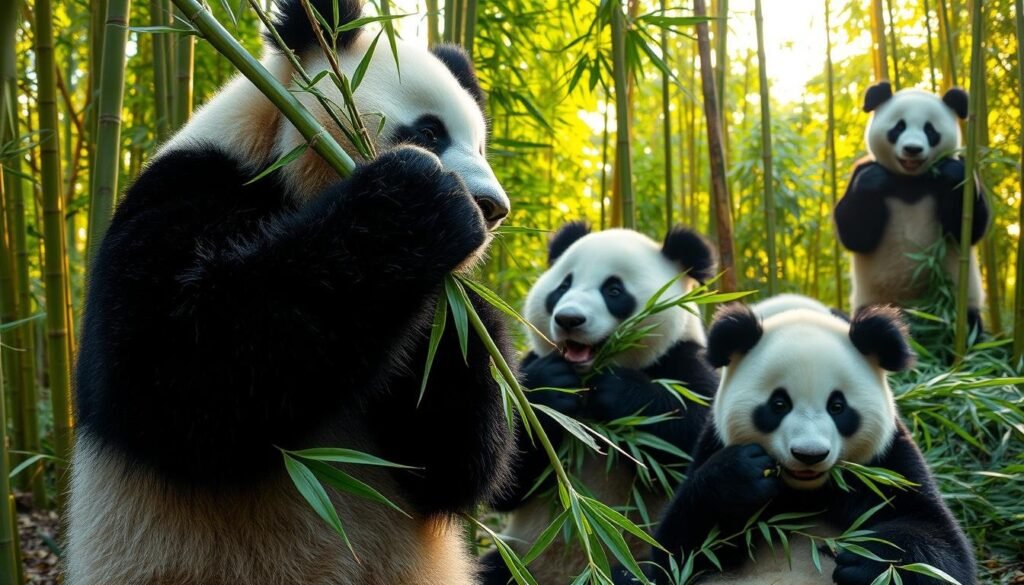Reason Pandas Eat Bamboo All Day: Have you ever wondered why giant pandas eat so much bamboo? It’s a key part of their survival. In fact, bamboo makes up about 99% of their diet.
Learning about the giant pandas’ bamboo consumption is both interesting and important. It helps us understand their unique lifestyle and role in nature. This knowledge is vital for protecting these amazing animals.
As you continue reading, you’ll learn more about pandas and their bamboo diet. You’ll see how this diet has shaped who they are today.
Contents
- 1 The Bamboo Diet of Giant Pandas
- 2 Why Do Pandas Spend Most Time Eating Bamboo?
- 3 The Evolutionary Paradox: Carnivores Turned Herbivores
- 4 The Ecological Role of Pandas’ Bamboo Consumption
- 5 Conclusion: Reason Pandas Eat Bamboo All Day
- 6 FAQ
- 6.1 What do pandas primarily eat?
- 6.2 Why do pandas spend most of their time eating bamboo?
- 6.3 How much bamboo do pandas eat in a day?
- 6.4 What makes bamboo a suitable food source for pandas?
- 6.5 How do pandas digest bamboo?
- 6.6 What is the pseudo-thumb evolution in pandas?
- 6.7 How do pandas contribute to their ecosystems?
- 6.8 What are the conservation implications of pandas’ specialized diet?
The Bamboo Diet of Giant Pandas
Giant pandas mostly eat bamboo, a plant full of nutrients. Almost all of their food is bamboo, making up about 99% of their diet.
Bamboo is packed with fiber, vitamins, and minerals. These are key for pandas to survive. The nutrients in bamboo vary by type, but it’s mostly carbs, proteins, and fiber.
Pandas eat different kinds of bamboo. Some eat up to 20-30 kilograms (44-66 pounds) of bamboo shoots, leaves, and stems daily. They need to eat so much because bamboo isn’t very nutritious.
Knowing about giant pandas’ bamboo diet helps us understand their role in nature. It also shows us how to protect and conserve these incredible animals.
Why Do Pandas Spend Most Time Eating Bamboo?
Pandas eat a lot of bamboo every day. But why? It’s because bamboo is full of nutrients they need to live. Plus, it’s easy to find in their homes.
Pandas can digest bamboo’s tough parts because of their special gut. This lets them get nutrients from bamboo, but it takes a long time. So, they eat all day to get enough food.

Here are some key reasons why pandas spend most of their time eating bamboo:
- Bamboo is a low-energy food source that requires constant grazing to meet nutritional needs.
- Pandas have a slow metabolism, which helps them conserve energy.
- Their digestive system is specialized to digest cellulose in bamboo.
- Constant eating helps pandas maintain their weight and energy levels.
The bamboo consumption rate of pandas is quite high; they can eat up to 20-30 kilograms (44-66 pounds) of bamboo shoots and leaves per day. This high consumption rate is necessary to compensate for the low nutritional value of bamboo.
Nutritional Needs and Bamboo
Pandas need certain nutrients that bamboo provides. Bamboo is full of nutrients like:
| Nutrient | Amount in Bamboo | Importance to Pandas |
|---|---|---|
| Cellulose | High | Provides fiber, aids digestion |
| Protein | Low to Moderate | Essential for muscle maintenance |
| Minerals | Variable | Crucial for various bodily functions |
Knowing why pandas eat so much bamboo helps us understand their special way of life. Their diet is a big part of how they survive in the wild.
The Evolutionary Paradox: Carnivores Turned Herbivores
Exploring the pandas’ history shows how they changed from meat-eaters to plant-eaters. The giant panda, part of the Ursidae family, used to be a carnivore. Now, they mainly eat bamboo. This change required many adaptations.
The pseudo-thumb is a key adaptation for pandas. It’s not a real thumb but a wrist bone that acts like one. This lets pandas hold bamboo stalks easily. It’s a great example of evolutionary ingenuity.
The pseudo-thumb helped pandas eat bamboo. They can grasp bamboo thanks to their “thumb.” This has been crucial for their survival in their habitats.
Taste Receptor Mutations
Pandas also have special taste receptor mutations. These changes help them eat bamboo, which tastes bland to humans. Bamboo is rich in nutrients, though.
These taste receptor changes are important for pandas. They let pandas eat lots of bamboo without being put off by its taste. Their pseudo-thumb and taste changes help them thrive on bamboo.
The story of pandas shows how evolution can change animals. From meat-eaters to plant-eaters, pandas have made big changes. Knowing about these changes helps us understand pandas better and how to protect them.
The Ecological Role of Pandas’ Bamboo Consumption
Pandas eating bamboo is key to their ecosystem. It affects bamboo numbers and the whole biodiversity. When you look at where pandas live, you see how their food choices impact their homes.
Pandas do more than just eat bamboo. They spread bamboo seeds, helping bamboo forests grow. This helps bamboo forests stay healthy and strong.
Key Ecological Contributions of Pandas
- Influencing bamboo population dynamics through selective consumption
- Dispersing bamboo seeds, promoting the spread of bamboo forests
- Creating pathways and clearings that can be used by other species
Pandas also shape their ecosystems with their bamboo eating. Their eating habits change how bamboo grows. This affects other animals that live in bamboo forests.
It’s important to save pandas and their homes. Protecting pandas helps keep their ecosystems balanced. This is vital for the health of our planet.
Thinking about pandas and bamboo shows why we must protect them. Their role in nature teaches us about the connection between all living things. We need to work together to save their homes.
Conclusion: Reason Pandas Eat Bamboo All Day
The pandas’ need for bamboo makes them vulnerable to changes in bamboo. This means conservation efforts must protect and restore bamboo forests. The pandas’ diet has big conservation implications that need to be addressed.
It’s important to understand the complex relationships between pandas, bamboo, and their ecosystems. This knowledge helps us work towards a future where pandas can thrive. Protecting their food source is key to their survival.
See Also: Why Do Foxes Bury Food Remains in Soil?
FAQ
What do pandas primarily eat?
Pandas mainly eat bamboo, which makes up about 99% of their diet.
Why do pandas spend most of their time eating bamboo?
Pandas eat bamboo a lot because it’s easy to digest. It’s also a low-energy food that they need to eat constantly.
How much bamboo do pandas eat in a day?
Pandas can eat up to 20-30 kilograms (44-66 pounds) of bamboo daily. This includes shoots, leaves, and stems.
What makes bamboo a suitable food source for pandas?
Bamboo is full of nutrients like fiber, vitamins, and minerals. These are key for pandas to survive.
How do pandas digest bamboo?
Pandas have a special digestive system. It lets them break down bamboo’s cellulose, something most animals can’t do.
What is the pseudo-thumb evolution in pandas?
The pseudo-thumb is a wrist bone that acts like a thumb. It helps pandas grasp and move bamboo stalks easily.
How do pandas contribute to their ecosystems?
Pandas help spread bamboo seeds. This helps bamboo forests grow and become more diverse. They also shape their ecosystems.
What are the conservation implications of pandas’ specialized diet?
Pandas’ diet makes them vulnerable to bamboo changes. Conservation efforts must protect and restore bamboo forests to help them.

Zyair Larson, based in Denver, Colorado, has over 12 years of experience studying animal behavior. He has worked with the World Wildlife Fund (WWF) and National Geographic, researching wildlife and sharing insights on animal habits globally.

